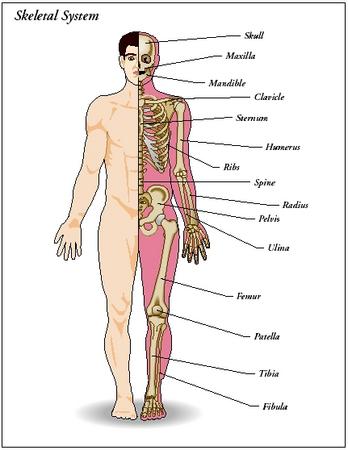 In "Egil's Bones" by Jesse L. Byock, Egil is "deaf, often lost his balance, went blind, endured headaches,[and had] unusual disfigurements of his skull and facial features" The anatomy and physiology of the bones that produced these symptoms are centered on the bone cells due to Pagets disease. In Paget's disease the Osteoblasts (the building cells) continually put down new matrix and bone material, yet the osteoclasts (the destroying cells) aren't working to help make room for new bone. This causes the bone to continually thicken and get bigger in ways that are not normal or healthy. This uncontrollable bone growth is the cause of Egil's disfigurements because his bone is regulated by the osteoclasts and osteoblasts and one of them was not working properly as a team. These disfigurements left the bones shaped unusually and caused a loss of weight balance due to unusual and uneven bone mass and unsound structure. Also because the new bone isn't growing and shaping the right way we see a lot of Egil's problems especially in the skull area. Literally the bones in his skull grew to big to allow other parts of the body to function. For example the eyes in their sockets become crushed as well as the nerves of the eyes that help you see. Without the proper connections and room the eyes loose vision and that is why Egil became blind. The same type of thing occurs with the ears. The loose of hearing comes from the bones crushing the inner ear that allows for hearing. And from here you could probably guess why he had headaches, but you'd probably be wrong. You might think comes from the skull crushing the brain, it actually comes from the vertebrae crushing the spinal chord that brings nerves from the body to the brain. So in these few ways of hearing loss, blindness, headaches, and unusual disfigurements Egil's problems could be explained by Paget's Disease.
In "Egil's Bones" by Jesse L. Byock, Egil is "deaf, often lost his balance, went blind, endured headaches,[and had] unusual disfigurements of his skull and facial features" The anatomy and physiology of the bones that produced these symptoms are centered on the bone cells due to Pagets disease. In Paget's disease the Osteoblasts (the building cells) continually put down new matrix and bone material, yet the osteoclasts (the destroying cells) aren't working to help make room for new bone. This causes the bone to continually thicken and get bigger in ways that are not normal or healthy. This uncontrollable bone growth is the cause of Egil's disfigurements because his bone is regulated by the osteoclasts and osteoblasts and one of them was not working properly as a team. These disfigurements left the bones shaped unusually and caused a loss of weight balance due to unusual and uneven bone mass and unsound structure. Also because the new bone isn't growing and shaping the right way we see a lot of Egil's problems especially in the skull area. Literally the bones in his skull grew to big to allow other parts of the body to function. For example the eyes in their sockets become crushed as well as the nerves of the eyes that help you see. Without the proper connections and room the eyes loose vision and that is why Egil became blind. The same type of thing occurs with the ears. The loose of hearing comes from the bones crushing the inner ear that allows for hearing. And from here you could probably guess why he had headaches, but you'd probably be wrong. You might think comes from the skull crushing the brain, it actually comes from the vertebrae crushing the spinal chord that brings nerves from the body to the brain. So in these few ways of hearing loss, blindness, headaches, and unusual disfigurements Egil's problems could be explained by Paget's Disease.http://www.viking.ucla.edu/Scientific_American/images/scan1.jpg
http://www.veterans.gc.ca/eng/services/disability-benefits/benefits-determined/entitlement-eligibility-guidelines/pagets
http://my.clevelandclinic.org/orthopaedics-rheumatology/diseases-conditions/hic-pagets-disease.aspx



